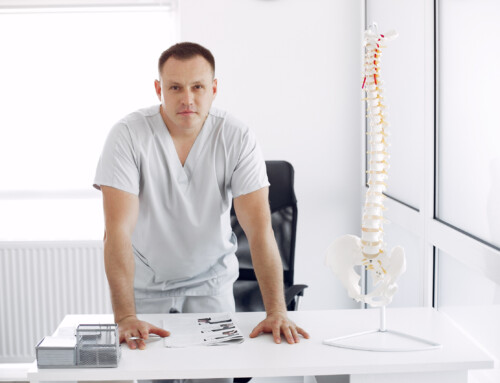Intro
Your spine is a strong column of 33 vertebrae beautifully designed to support you throughout your life. As we get older, unfortunately, damage to our spine may result in fractures in our vertebrae. If this occurs, kyphoplasty can help heal the damage. If you’re considering this treatment, here’s what you should know about the procedure, as well as kyphoplasty recovery time and process.
Want to learn more? Our Raleigh area pain management team at Wake Spine & Pain is always here to answer your questions.
What is the kyphoplasty procedure?
Kyphoplasty is an interventional pain management procedure that can restore the stability of your spine after a vertebral fracture. These fractures may cause significant back pain. They occur most commonly due to the following conditions:
- Osteoporosis: Bone thinning that increases the risk of fractures
- Injury: Trauma that compromises vertebral integrity
- Cancer: Certain cancer treatments can weaken bones, making fractures more likely
If you experience a vertebral fracture due to one of these conditions, your doctor may recommend kyphoplasty. With this procedure, they’ll insert a medical balloon into the vertebrae to restore height and space in the spine. Specialized cement is then injected into that balloon space. The cement creates stability in your individual vertebrae and the spine as a whole.
During the procedure, your doctor will use X-ray guidance to ensure proper placement of the balloon and the cement. The whole process takes about one hour (per vertebrae).
The basics of kyphoplasty recovery
The recovery process varies from patient to patient. It’s important to follow all of the specific kyphoplasty recovery instructions provided by your doctor, as they’ll have a better understanding of your unique health history and risk factors.
What happens after kyphoplasty?
kyphoplasty is performed under general anesthesia,
- You will rest under observation for a few hours or overnight, depending on your doctor’s recommendation.
- Many patients can walk within an hour after surgery.
- Some soreness at the injection site is normal. Ice packs and over-the-counter pain medication can help.
- A friend or family member must drive you home the day of your procedure.
- Take the rest of your day off to rest.
What’s the typical kyphoplasty recovery time?
You may be up and around, resuming normal activities within just one day, but your kyphoplasty recovery may take longer if your health is poor or the procedure involves multiple vertebrae.
The typical kyphoplasty recovery time will vary depending on a few factors, including:
- The number of vertebrae involved: More vertebrae treated often means a longer recovery time
- Your overall health: Generally healthy people recover more quickly
- Complications during the procedure: Complications are rare but increase recovery time
What are the risks and potential complications?
Kyphoplasty is a minimally-invasive procedure that results in reduced pain and an improved quality of life. As with any interventional procedure, though, there is the potential for risks and complications. These can include:
- Infection
- Increased back pain
- Bleeding
- Nerve damage
- Allergic reaction to the cement
- Cement leaking
The risks are significantly reduced when this procedure is performed by trained and experienced physicians using X-ray guidance. Look for pain management specialists with dedicated experience performing this procedure.
Are there any restrictions after kyphoplasty?
As with all of these guidelines, restrictions after kyphoplasty may vary depending on your doctor’s guidance, your overall health, and the procedure itself.
Some of the basic restrictions after kyphoplasty typically include the following:
- Avoid Driving: Do not drive for 24 hours after your procedure (or until your doctor gives the go-ahead)
- Limit Lifting: anything that causes you to strain your back for the first 24 hours
- Refrain from vigorous exercise: Minimize heavy lifting and vigorous exercise for four to six weeks
- Resume medications as directed by your doctor
Many patients return to their daily activities within a few days following their procedure. If your job or leisure time features heavy lifting or repetitive motions in your back (i.e., twisting to play tennis or stooping down to garden), talk to your doctor about how to do that safely.
When will I experience pain relief?
Generally speaking, many patients experience almost instantaneous relief from pain after kyphoplasty. For some, it may take longer to experience pain relief—usually within 48 hours.
If you are not completely pain-free immediately, this is not a cause for alarm. Each person’s recovery process is unique to them. Talk to your doctor if you are still experiencing pain a week after your procedure, or if you experience any severe or sharp pains.
At-Home Care for Kyphoplasty Recovery
The kyphoplasty recovery process continues at home after your procedure.
- Keep your bandage clean and dry to prevent infection.
- Use ice packs : it is normal to feel minor soreness at the injection site. Use ice to reduce swelling and pain, applied in a 20-minutes-on and 20-minutes-off cycle to find relief.
- Take Over-the-counter non-steroidal anti-inflammatory drugs can also help relieve pain and inflammation.
- Listen to your Body It’s important to rest and take care of yourself. Pay attention to what your body needs. If your back becomes sore after moderate activity, for example, take a break.
- Incorporate gentle stretching and strengthening exercises An important part of kyphoplasty recovery is resuming your normal activities when you feel ready. This includes stretching and strengthening exercises to help support the spine. Ask your doctor for guidance on which exercises or physical therapy regimen will best support your kyphoplasty recovery.
Learn more about kyphoplasty
At Wake Spine & Pain, our North Carolina pain management doctors are board-certified and fellowship-trained in both anesthesiology and physical medicine/rehabilitation. Due to this multi-disciplinary approach, our physicians have dedicated experience in diagnosing and treating a variety of pain conditions.
We work hard to help our patients reclaim their lives from pain. For kyphoplasty procedures, we perform them in our comfortable and affordable outpatient clinic. There is no need to visit an interventional radiologist, ER, or hospital for your kyphoplasty procedure, with the related costs that these visits can incur.
At Wake Spine & Pain, we’re committed to delivering timely care to help you get back to your life. Most patients are scheduled within 48 hours.
📞Give us a call today at (919) 322-1835 or schedule your appointment here.
Frequently Asked Questions(FAQ)
- How long does the bone cement take to fully harden?
The bone cement used in kyphoplasty hardens within minutes, allowing for immediate stabilization of the vertebrae. However, the surrounding tissues may still need time to adjust, so it’s essential to follow post-procedure care guidelines. - Will kyphoplasty completely cure my back pain?
Kyphoplasty significantly reduces pain for most patients, but the amount of relief varies. If you have multiple spinal conditions, additional treatments such as physical therapy, medications, or lifestyle changes may be recommended. - Can kyphoplasty prevent future fractures?
While kyphoplasty stabilizes the treated vertebrae, it does not prevent future fractures. Maintaining bone health through calcium, vitamin D, weight-bearing exercises, and osteoporosis treatment is essential for long-term spine health. - What is the success rate of kyphoplasty?
Studies show that over 85-90% of patients experience significant pain relief and improved mobility after kyphoplasty. Success depends on factors like overall health, the severity of fractures, and post-procedure care. - Can I travel after kyphoplasty?
Most patients can travel within a few days, but it’s best to avoid long trips immediately after the procedure. If flying, walk around periodically and stay hydrated to reduce the risk of blood clots. Always check with your doctor before making travel plans. - Will I need follow-up appointments after kyphoplasty?
Yes, your doctor will schedule a follow-up visit to monitor healing and ensure the procedure was successful. Additional imaging (X-rays or MRIs) may be done if needed. - Can I sleep on my back after kyphoplasty?
Yes, but you should use a supportive mattress and pillow to maintain proper spinal alignment. Some patients find relief sleeping on their side with a pillow between their knees. - Does insurance cover kyphoplasty?
Most insurance plans, including Medicare, cover kyphoplasty if it is deemed medically necessary. Check with your provider for details on coverage and out-of-pocket costs. - Are there any warning signs I should watch for after the procedure?
Contact your doctor if you experience:
- Severe or worsening pain that doesn’t improve
- Signs of infection (redness, swelling, fever)
- Numbness or weakness in your legs
- Difficulty breathing or chest pain
- Will I need physical therapy?
In some cases, physical therapy can help strengthen your back and improve mobility. Talk to your doctor about whether a rehabilitation program would benefit you.
References
- National Osteoporosis Foundation – Information on osteoporosis and vertebral fractures.
🔗 https://www.nof.org/ - American Academy of Orthopaedic Surgeons (AAOS) – Guidelines on kyphoplasty and vertebroplasty.
🔗 https://orthoinfo.aaos.org/en/treatment/kyphoplasty-and-vertebroplasty - Spine-Health by Veritas Health – In-depth articles on kyphoplasty recovery and spinal procedures.
🔗 https://www.spine-health.com/treatment/back-surgery/kyphoplasty-procedure - RadiologyInfo.org (by the RSNA & ACR) – Imaging and procedural details for kyphoplasty.
🔗 https://www.radiologyinfo.org/en/info/vertebro - Cleveland Clinic – Recovery expectations and post-procedure care for kyphoplasty.
🔗 https://my.clevelandclinic.org/health/treatments/15834-kyphoplast/ - Spine Health Journal. “Minimally Invasive Procedures for Spinal Fractures.”
Disclaimer: This information is for educational purposes only and is not a substitute for professional medical advice. Always consult with a healthcare provider for a personalized treatment plan.







